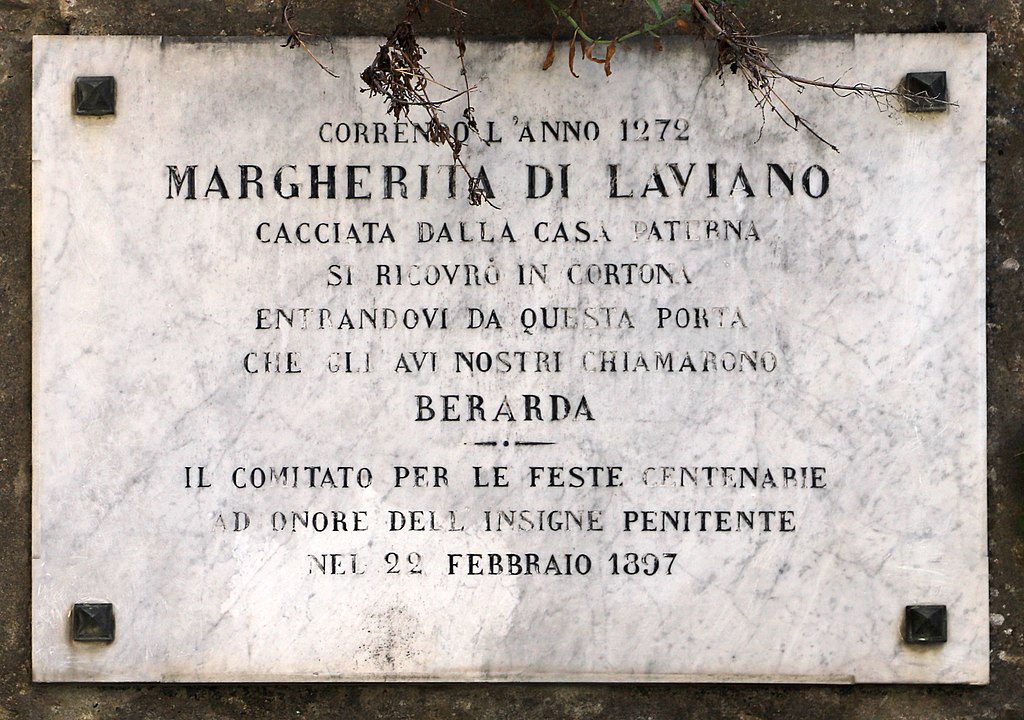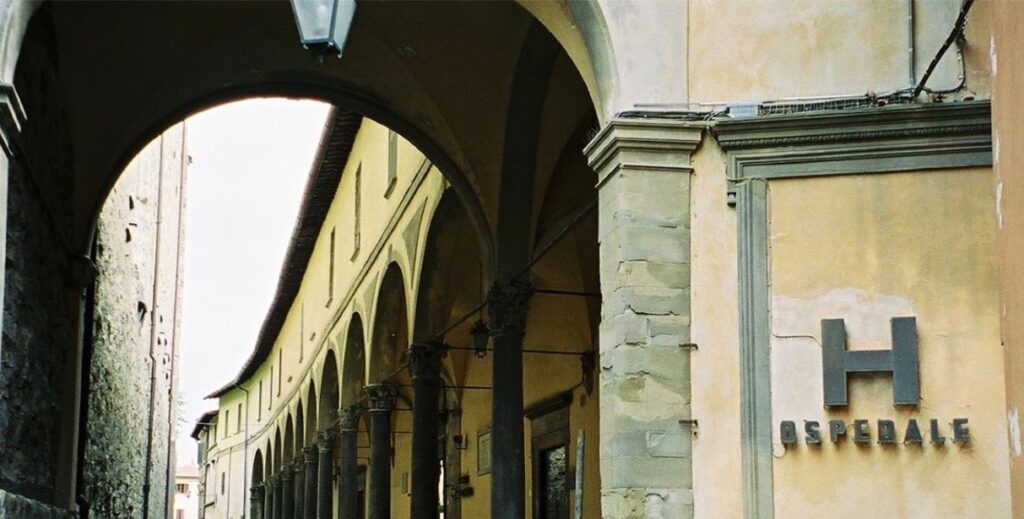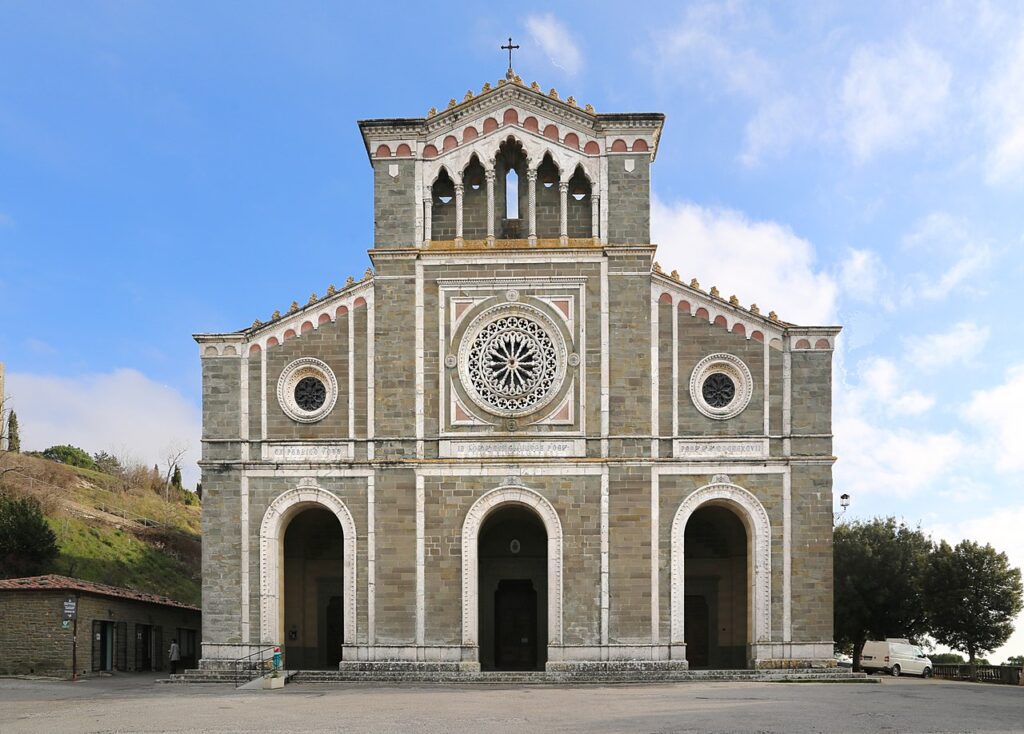Susan Brunn Puett
J. David Puett
Chapel Hill, North Carolina, United States

From humble beginnings to years as a mistress, Margherita altered her path to become a tertiary Franciscan penitent, attending the ill and poor, founding a hospital, and devoting herself to Christ. She was in the vanguard of several other women of the late Middle Ages who defied their expected societal roles. The background material documenting Margherita’s life is derived from her Franciscan confessor and hagiographer, Fra Giunta Bevegnati, in Legenda, written about 1305–1308.1
The early years
Born in 1247, Margherita lived in the Umbrian community of Laviano, where her father farmed rented land. When Margherita was about eight, her mother died; her father then married a woman with whom Margherita had a difficult relationship. The beautiful Margherita was wooed by several noblemen of the area, one of whom impregnated her at age fifteen. Because marriage to him was out of the question, and she was now unwelcome in her childhood home, the pregnant Margherita braved the treacherous Val di Chiana to be with her lover in a villa near Montepulciano. Living there for nine years with the nobleman and their son, Arriguccio, she often appeared wearing elegant clothing. This genteel existence ended when her beloved failed to return from a hunting trip. His dog appeared at the villa and led Margherita to the nobleman’s slain body. The murderer was never identified. Knowing her protected status had ended, Margherita returned with Arriguccio to her childhood home, only to be rejected. In about 1272, and now in her middle twenties, the intrepid Margherita dressed herself in coarse penitent’s clothing. With her son, she traversed the twenty-mile valley to the small Tuscan hill town of Cortona, where she hoped to repent of her sins and enter one of the Franciscan houses.
Thirteenth-century Cortona
This was a tumultuous time in Italy with two opposing factions: the Ghibellines, who favored Emperor Frederick II, and the Guelfs, who supported the dictates of the pope. The populace of Cortona, under the leadership of the powerful Casali family, endorsed the emperor, while those in the neighboring city of Arezzo were staunch allies of the pope. Warring factions kept the opposing sides in constant turmoil. In 1234, Pope Gregory IX placed the city of Cortona under papal interdict that continued under Innocent IV. In spite of these constraints, the city flourished and expanded.
In 1248, a year after Margherita’s birth, the pope, hoping to alleviate the monetary problems in Arezzo’s corrupt diocese, demanded financial support from Cortona. When this was refused, the papal interdict was extended under Alexander IV. Because the interdict had accomplished little, the bishop of Arezzo made the decision to capture Cortona. On February 1, 1258, two Franciscan brothers opened one of the gates in the town wall, enabling the Guelf forces to enter. Cortona was ransacked and burned, the Ghibellines were exiled, and the town was placed under the jurisdiction of the commune of Arezzo. In 1261, with the help of Perugia, the Ghibellines were able to retake Cortona, leading to the signing of an alliance with Arezzo in 1266. The long-standing interdict was lifted. Relative peace was restored, and the slow process of rebuilding began.
When the destitute and homeless Margherita reached Cortona, she found a community, much of which remained in disrepair, with many sick and indigent citizens and few social services or health facilities. The Franciscans had, however, established a firm foothold in the region following the arrival and building programs of St. Francis and Brother Elias.
Margherita’s life in Cortona

Margherita and her son entered Cortona’s Berarda Gate (Figure 1). Fortunately for them, they encountered two noblewomen of the Moscari family, who offered to provide the itinerant visitors lodging at their palazzo on Via Maffei, in close proximity to the Church of San Francesco. This was a particularly important offer to Margherita since her background prevented her from immediately being accepted into one of the religious orders. During the three years of living with the Moscaris, Margherita began caring for the sick, assisting as a midwife, begging for the indigent, and helping her host family with meals.
Sometime between 1275–1277, the Franciscans reluctantly permitted Margherita to wear the habit of a lay penitent,2 followed later by becoming a Franciscan tertiary. After leaving the Moscari residence, Margherita moved to a small cell near the Church of San Francesco where she spent thirteen years in prayer while providing health care, serving as a midwife, and continuing to help the poor. This was a time when she also subjected herself to extreme austerities, including fasting, self-flagellation, and sleep deprivation.3 During this period, she enacted a twelve-hour Passion of Christ in the Church of San Francesco, in which her performance moved the audience to tears and ended as she experienced the Crucifixion, appearing to have perished.4,5
As word of Margherita’s commitment to the ill spread, in 1286 the bishop of Arezzo granted her a charter for a hospital in Cortona. After accomplishing the formidable task of securing initial funding, mainly from a lay fraternity she formed, Margherita was able to open the Santa Maria della Misericordia Hospital on Via Maffei. Its mission was not only to care for the sick and indigent, but also to house pilgrims and protect abandoned children. Along with brothers of the Third Order of St. Francis, Margherita established a group of Franciscan tertiary sisters, known as “le poverelle,” to staff the new institution. In the years that followed, and long after Margherita’s death, the hospital continued to grow in size and services. By the 1440s, the hospital had expanded on land both purchased and donated. Etruscan vaults underneath the building support the present-day structure. A portico with eleven Renaissance arches, most probably designed by Giovanni and Francesco Berrettini of Cortona, enhanced the appearance of the exterior (Figure 2). Markers on various entrances added in the ensuing years document the opening of wings in 1489 and 1594.6

As with many hospitals of the period, the interior contained two cloister-type courtyards, as well as a chapel. Art with religious themes was used throughout chapels, cloisters, and wards to invoke reflection and prayer. Works were commissioned from prominent artists to provide focus for those in need of spiritual solace and to remind patients and their loved ones of the Divine’s power to heal.7 In Santa Maria della Misericordia, the chapel contained frescoes focusing on the miracles that Margherita was said to have performed, as well as three altars and an altarpiece with Margherita’s image. Some of those works are now displayed in Cortona’s Diocesan Museum. Santa Maria della Misericordia underwent extensive renovations in the 1700s and continued to add services. After about seven centuries of continuous operation, the hospital was permanently closed in 2005 in favor of a newer facility in the valley.
In 1288, Margherita moved to a small cell further up Mt. Sant’Egidio, and in 1290, the bishop of Arezzo granted her permission to restore the Church of San Basilio adjacent to her cell, now the Basilica of Santa Margherita (Figure 3). During this time of contemplation and prayer, Margherita was the recipient of messages from Christ directing her to preach the importance of peace. Since medieval women were banned from preaching in public,8 Margherita followed Christ’s dictates by using pedagogical performances and discussions with individuals and small groups. Such a heuristic approach used to disseminate her conversations with Christ enabled Margherita to gain a faithful following. After a seventeen-day fast, Margherita, age fifty, died in 1297. Her body was embalmed and is preserved in a silver casket above the altar of the Basilica of Santa Margherita. She received papal beatification in 1623 and was canonized in 1728.
Margherita joined the ranks of other thirteenth-century women, such as Saint Agnes of Bohemia and Saint Elizabeth of Thuringia, who defied tradition and devoted their lives to the Franciscan cause while caring for the sick and building hospitals.9 Santa Margherita’s strength lay in her tenacity and ability to persuade, demonstrating fierce determination and steadfast resolve. For six centuries, this paragon of religious passion continued to inspire works by prominent artists, including most probably one by the noted Sienese Ambrogio Lorenzetti (1290–1348)10 and, in the twentieth century, the creation of an opera, Margherita da Cortona, by Licino Refice (1883–1954), with libretto by Emidio Mucci.
References
- Bevegnati, Fra Giunta. The Life and Miracles of Saint Margaret of Cortona (1247-1297). Translated by Thomas Renna and edited by Shannon Larson. St. Bonaventure, NY: Franciscan Institute Publications, 2012.
- Doyno, Mary Harvey. “The Creation of a Franciscan Lay Saint: Margaret of Cortona and Her Legenda.” Past and Present no. 228 (August 2015): 57-91 (see p. 57).
- Bornstein, Daniel. “The Church and the Cult of Santa Margherita da Cortona.” Church History 62 (1993): 163-177 (see p. 165).
- Muessig, Carolyn. “Performance of the Passion: The Enactment of Devotion in the later Middle Ages.” In Visualizing Medieval Performance, edited by Elina Gertsman, 129-142 (see pp. 131-133). Farnham, UK: Ashgate Publishing LTD, 2008.
- Kienzle, Beverly Mayne. “Margherita of Cortona: Women Preaching, and the Writing of Hagiography.” Medieval Sermon Studies 54 (2010): 38-50 (see pp. 42-44).
- Holder, Philancy N. Cortona in Context. 2nd ed. Edited by Thomas A. Pallen. Clarksville, TN: HP Publishing, 2006: 180-181.
- Puett, Susan B. and J. David Puett. Renaissance Art and Science @ Florence. Kirksville, MO: Truman State University Press, 2016 (Distributor: University Park, PA: Pennsylvania State University Press): 129.
- Kienzle, “Margherita of Cortona,” 40-41.
- Puett, J. David. “Saint Agnes of Bohemia: A Thirteenth-Century Iconoclast and the Enduring Legacy of Her Convent as a Sacred Space for Religious Art.” Religions 12 (2021): 826. https://doi.org/10.3390/.
- Cannon, Joanna and Andre Vauchez. Margherita of Cortona and the Lorrenzetti. University Park, PA: Pennsylvania State University Press, 1999.
SUSAN BRUNN PUETT has a BA in history and education from Duke University. After a career in teaching and addiction counseling, she is now an independent scholar who is published in history (two books and several articles) and poetry. Consistent with her focus on the Italian Renaissance, she co-authored Renaissance Art & Science @ Florence and co-led honors students from the University of Georgia to Florence, Italy.
J. DAVID PUETT has BS and MS degrees in physics and a PhD in biochemistry. Having held faculty positions at several universities, he is widely published in science. He has also co-authored a book and several papers in history with Susan B. Puett, has written a scholarly article on St. Agnes of Bohemia, and has published a book of fiction.
Highlighted in Frontispiece Volume 15, Issue 3 – Summer 2023

Leave a Reply